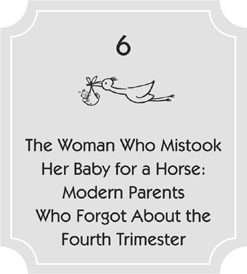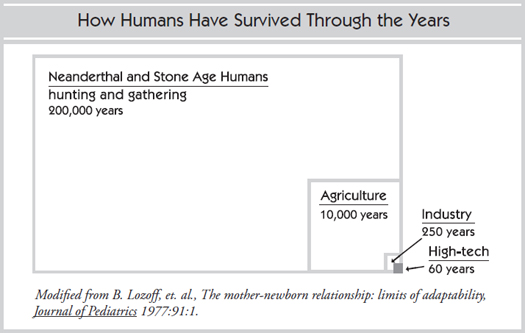

Main Points:

That which was done is that which shall be done; and there is no new thing under the sun.
Ecclesiastes 1:9

Picture a crisp December day, gleaming like a jewel. Yesterday your life changed with the birth of a beautiful baby boy. Now, as the nurse wheels his bassinet into your room, your son lifts his fragile head, slowly turns to face you, and flashes a big grin! Then he vaults into your arms and, with a laugh that makes your heart melt, proclaims, “You’re the best mom in the whole world!”

Of course, no one expects their baby to walk and talk right after birth. However, many modern parents are unprepared for how dependent and vulnerable newborns truly are. They expect their babies to be more mature, sort of like baby horses! Within minutes of birth, newborn horses can stand, walk, and even run. A baby horse’s survival depends on these crucial abilities to keep away from hungry predators. By comparison, our new babies are still immature little fetuses.
After the first month, I wanted some recognition that my twin girls could distinguish me from the woman down the block. When Audrey was two months old, she peed on me, then suddenly smiled. I know it sounds crazy but I was ecstatic!
Debra, mother of Audrey and Sophia
When I teach prenatal classes I often ask the parents-to-be to describe the differences between four-day-old and four-month-old babies. Those without much baby experience usually answer that a four-month-old is like a newborn, except bigger and more alert.
In fact, there are gigantic differences between these two ages. As extraordinary as newborns are, their ability to interact with the world is extremely limited. While a four-day-old can’t even coo or turn around to see who’s speaking, a four-month-old’s delicious smile and glowing eyes reach out like a personal invitation to join her on her amazing life journey.

As noted earlier, baby horses depend on brawn for their survival, so their developed bodies are as big as they can possibly be when they pop out of their mothers’ wombs. By contrast, our babies’ survival depends on their brains. For that reason, at birth, their heads are as big as they could possibly be and not get stuck. Then amazingly, during the first three months, a baby’s brain balloons an additional twenty percent in size. Accompanying that growth is an explosive advance in her brain’s speed, organization, and complexity. No wonder parents notice their babies suddenly “wake up” as the fourth trimester draws to a close.
Our ancient relatives realized how immature their babies were at birth. Over the centuries, they discovered that the most effective way of caring for newborns during the early months of infancy was by imitating their previous home—the uterus!
Sensory Abilities
• Can focus only on objects eight to twelve inches away.
• Love looking at light/dark contrasts and designs.
Four-Month-Old Babies
• Easily focus on large objects across a room.
• Can turn their head to find where a sound comes from.
Social Abilities
Four-Day-Old Babies
• More attracted to the sound of the human voice than to music or noise. Can recognize their mother’s voice from the muffled sounds they heard in the womb.
• Prefer looking at a person’s face rather than an object. May be able to imitate facial expressions like a mom opening her mouth or sticking out her tongue.
Four-Month-Old Babies
• Patiently wait for you to stop talking before they take a turn in the conversation by releasing a symphony of coos, grunts, and giggles.
• Enamored with their parents’ faces and brighten visibly when they enter the room. Smile and coo to make their parents smile and may become upset when ignored.
Motor Abilities
Four-Day-Old Babies
• Often get crossed eyes. Can follow only slowly moving objects and have very jerky eye movements.
• Hard for them to get their fingers to their mouths and very hard for them to keep them there for more than thirty seconds.
Four-Month-Old Babies
• No longer get crossed eyes. Can now follow objects swiftly and smoothly as they move around the room.
• Much more able to reach out and touch objects. Easily get their fingers to their mouths and keep them there for many minutes.
Physiological Characteristics
Four-Day-Old Babies
• Hands and feet are blue much of the time.
• Bodies occasionally get jolted by hiccups, jittery tremors, and irregular breathing.
• Have little ability to control body movements.
Four-Month-Old Babies
• No longer get blue hands and feet unless cold.
• Rarely hiccup, never tremor, and breathing is smooth and regular.
• Much better at controlling body movements. Can roll over, spin around, and lift head high off the mattress.
Do you remember how in Star Wars Luke Skywalker achieved victory by using the long forgotten powers of the Force? Well, over the last fifty years, our society has also advanced by returning to ancient wisdom such as getting more exercise, protecting the environment, and eating food grown with less pesticides. Technology is a blessing, but today we are relearning the value of living in harmony with nature; it’s just common sense!
That’s why there’s logic in examining the past to understand ourselves better. Although our clothes and music are contemporary, our biology is clearly prehistoric, and that’s especially true for babies.

In the diagram above, we occupy the tiny bottom right corner, the technological age of man. Yet our babies are far from high-tech. In most respects, they haven’t changed a hair in the past thirty thousand years! That’s why, although most of us would never survive if suddenly sent back to the Stone Age, our infants would feel right at home. Babies expect to be born into a cave family, and they expect us to be as experienced at handling them as our Stone Age cousins were. Unfortunately, most of us are a little rusty—if not completely in the dark—when it comes to those prehistoric parenting tips. What valuable baby-care tricks could you learn if an experienced cave mother lived next door to you?
While we can’t go back in time, we can get an idea of some calming techniques cave moms might have used by looking through a virtual “window” to the past, the study of primitive tribes living around the world today.
Please don’t be fooled by the word primitive. Although it conjures up images of backward people, over the past eighty years research has shown that many so-called primitive peoples possess wisdom of the natural world about which we are ignorant. Some know the medicinal power of rare plants, some know how to find water in the desert—and some even know how to prevent colic!
For hundreds if not thousands of years, the !Kung San (or African bushmen) have lived in isolation on the plains of the Kalahari Desert. Over the past forty years, however, the !Kung have graciously allowed scientists to observe their lives, including how they care for babies.
I’ve read reports of their newborn care with great interest because !Kung infants hardly ever cry. It’s not that they never cry—it’s that they never CRY! (And I know you understand that distinction.) While !Kung infants get upset as often as our babies do, their parents are so skilled at soothing them that the average fussy bout lasts only sixteen seconds, and more than ninety percent of their crying jags end in under a minute.
What’s their secret? What ancient wisdom do the !Kung know that our culture has forgotten? I believe three facts account for much of this tribe’s stunning success:
• !Kung mothers hold their babies almost twenty-four hours a day.
• !Kung mothers breast-feed their babies around the clock.
• !Kung parents usually respond to their babies’ cries within ten seconds.
!Kung mothers carry their babies all day long in a leather sling and sleep next to them at night. This closeness makes it easy to soothe any fussiness the instant it starts.
In addition to holding and cuddling, the !Kung calm their babies by giving them quick little feedings on the breast—up to one hundred times a day! We in the West might think such snacking would spoil a baby, but that’s not the case. Despite the lavish and immediate attention paid to their crying, !Kung children grow up to be happy, independent, and self-sufficient.
Now, don’t worry. I’m not suggesting we adopt all the !Kung ways; they clearly don’t fit our busy lives. However, I am suggesting that we study these highly successful parents to learn which of their solutions could be easily adopted by Western moms and dads.
I believe the biggest secret the !Kung know is that all their baby soothing methods share a common thread: They imitate the uterus and provide babies the comfort of the fourth trimester.
Compared to our infants, !Kung babies may be deprived of many material possessions, but compared to the !Kung, our babies are deprived of an important “maternal” possession—long hours of being in our arms. While !Kung mothers are with their infants almost nonstop, studies in the United States show that we leave our young babies alone for up to sixteen hours a day. I’m afraid that for many newborns, this abrupt transfer from cozy womb to empty room ends up making them terribly upset.
For the first few months of life, we need to treat our babies the way our ancient ancestors treated theirs thousands of years ago, with the reassuring rhythms of the fourth trimester. In other words, we should no longer mistake our newborns for little horses. Rather, we should treat them like little kangaroos! Kangaroos “know” their babies need a few more months of TLC before they’re ready to get hoppin’, so they welcome them into the pouch the moment they’re born. Likewise, we need to offer our sweet newborns “pouches” of prolonged holding, rocking, shushing, and warmth. If you do this you’ll be amazed. Once you master the skill of imitating the womb, you’ll be able to do exactly what !Kung moms do: settle your baby’s cries in minutes!
Imitating the womb to calm colic isn’t the only ancient wisdom that has been ignored by our culture. Over the past fifty years, researchers have carefully proved the benefits of another prehistoric skill, breast-feeding, which was rescued from the brink.
Within days of your baby’s birth, your breast milk appears, as if by magic. It’s exactly what the doctor, and your baby, ordered. This sweet, nutritious, easy-to-digest food gives your newborn an almost constant flow of nourishment, just like she had inside the womb.
Early in the 1900s, after millions of years of being developed to perfection, mother’s milk was suddenly abandoned in many parts of the world. It was nudged aside by mass-produced artificial formula that was promoted as equally healthful and more hygienic than mother’s milk. Many women were convinced that scientists knew better than nature. They fed their babies formula, mistakenly believing that the product of a chemist was better than the old-fashioned product of their own breasts.
Mothers asked their doctors for medicine to dry up their breast milk and to recommend their favorite commercial formula. By the 1950s, breast-feeding became so rare in America that the women who tried it were considered radical or eccentric.
Moms who still wanted to breast-feed often failed because they had no personal experience and little professional guidance. As unbelievable as it sounds, within two generations our culture almost lost this basic human ability that had sustained our species for millions of years! Fortunately, many committed women (and men) were appalled by this lack of support. Through their great efforts, groups like La Leche League were launched and specialists were trained to help new mothers rediscover this wonderful skill.
In recent years, public interest in breast-feeding has dramatically rebounded, spurred by an avalanche of research revealing the shortcomings of formula and the benefits of breast milk. Scientific studies show that breast milk helps build babies’ brains, boosts their immunity, protects them against diabetes, and lowers a woman’s risk of breast and ovarian cancer. Today, breast milk is so universally accepted as the preferred food for babies that even formula companies recommend women use their product only if they can’t breast-feed.
I’m thankful we have excellent artificial formulas to feed babies who are unable to feed at their mother’s breast. However, all medical groups agree, if you can do it, “breast is best” for feeding your baby.